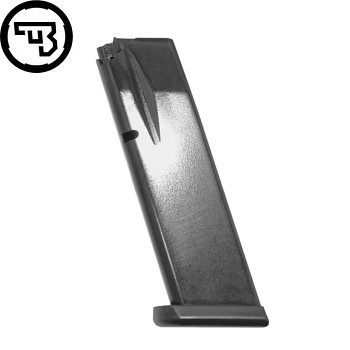Firearms for concealed carry and self-defense
Both models are based on the classic CZ 75, but their construction has been adapted by the developers for concealed carry, EDC and self-defense.
The CZ 75 Compact model is essentially a scaled-down full-size CZ 75 while retaining the steel construction.
The CZ P-01 goes further in weight reduction – besides being more compact it also received lighter material and is made of dural.
In this category you will find magazines for the following models:
-
CZ P-01,
-
CZ P-01 Ω,
-
CZ 75 Compact,
-
CZ 75D Compact,
-
CZ 75D PCR
How to choose a magazine
When choosing a new magazine take the following criteria into account:
Compatibility with the model
Magazines for both models are completely identical. You can also insert magazines from full-size models into these compact models, but they will protrude because they are longer.
For detailed information about magazine compatibility by model, see the
CZ Magazines Compatibility Guide, where you can find exactly which magazine can be used in which model.
Caliber and length
Magazines differ, among other things, in length. A longer magazine increases capacity, however the fact that it protrudes may worsen ergonomics and make the grip more difficult, or possibly prevent
magwell installation.
Capacity
Capacity determines how many cartridges fit into the magazine. With us you will find a
magazine for 15 rounds with a polymer base pad. Although capacity is related to length, the two parameters are not interchangeable. There exist magazines of the same length with different capacities.
How the magazine works and what can be improved
A magazine consists of several main parts.
Each has its specific purpose; some can be replaced for better weapon function and some you even have to replace if you want to upgrade the pistol with a magwell:
-
Body: the main part where cartridges are inserted, usually made of polymer, aluminum or steel.
-
Spring: pushes the follower up inside the magazine body, thus feeding cartridges into the chamber. It is the part most prone to wear — its strength decreases and feeding malfunctions occur.
-
Follower: a plastic part on top of the spring, where cartridges rest.
-
Base pad: holds the spring and follower inside the magazine body. Shooters often change this part of the magazine. Why?
-
Better durability when dropped,
-
Better weight distribution, where a heavier base pad improves the pistol’s behavior thanks to weight distribution,
-
Increased magazine capacity.
-
Possible ergonomic features for a more comfortable grip.
-
Installation of a magwell on the pistol – to be able to insert magazines, it is necessary to replace the base pads with ones that are compatible with the magwell.
Why consider getting a new magazine?
There are several reasons why you might want to get a new magazine:
Wear: even if you clean the magazine thoroughly and regularly, it is a consumable item and undergoes wear. A new magazine then guarantees quality and reliability.
Damage: rough handling, drops or pressure can cause damage.
More magazines = more convenience: Usually you get two magazines with the pistol by default. Constantly reloading you, especially during training or competition, will slow you down; it is much more comfortable and efficient to get more pieces that you simply swap.
Increased capacity: A longer magazine holds more cartridges. The same can be achieved by a suitable
base pad.
Magazine maintenance tips
Proper maintenance extends the magazine’s lifespan and ensures its reliability.
Cleaning
Clean the magazine after every training session and use.
Disassemble it according to the manual and wipe the body and base pad free of dust, gunpowder residue and excess lubricant. Clean the inside of the body, follower and spring with a soft brush or cloth.
Lubrication
Use a quality lubricant and apply it in a thin layer. Excess grease unnecessarily attracts dust.
Storage
Store magazines in a dry and dark place.
If you do not use the magazine for a longer period, store it unloaded to avoid unnecessary stress on the spring.
Pre-use inspection
Check that the base pad is not cracked and that it seats properly. Inspect the spring and follower.
Multiple magazines
If you have several magazines, they should be rotated regularly. It is useful to have several spare springs on hand.





